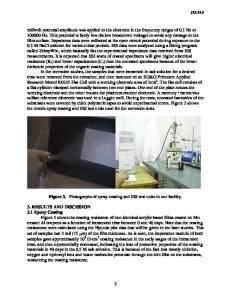Multifunctional Nanocomposite Coatings
- PDF / 117,165 Bytes
- 6 Pages / 612 x 792 pts (letter) Page_size
- 103 Downloads / 360 Views
MULTIFUNCTIONAL NANOCOMPOSITE COATINGS CORNÉ H.A. RENTROP, LAWRENCE F. BATENBURG, ROELANT A. VAN DAM, MARINUS P. HOGERHEIDE, HARRY A. MEINEMA, LEON H. GIELGENS, HARTMUT R. FISCHER,* TNO-TPD Materials research & technology, P.O. box 595, 5600 AN Eindhoven, The Netherlands ABSTRACT Multifunctional nanocomposite coatings and bulk materials have been developed on the basis of a combination of purely organic, as well as hybrid organicinorganic polymeric matrices and anisotropic synthetic and natural clays. The clays have been chemically modified in such a way that they became compatible to the polymeric matrices. Clay platelets may be separated by modification with an organic molecule that contains two or more charged functional groups. The cations or anions located between the clay sheets are exchanged with one of these organic functional groups, which results in the formation of clay platelets “coated” with charges, thereby causing a molecular dispersion. Depending on the nature of the organic molecule colored or colorless coatings and polymeric bulk materials, containing homogeneously dispersed separated clay platelets, have been obtained. While retaining the basic functional properties of the materials new and/or improved properties have been introduced. This concerns in particular improved barrier properties, such as a decreased permeability for oxygen and water, improved corrosion resistance and increased thermal stability. The composition of the wet coating systems is such that they can be properly applied and thermally or photo-chemically cured on various substrates such as glass, steel, aluminum and plastics. The bulk materials can be processed into final product shapes by conventional polymer processing techniques. INTRODUCTION Polymer nanocomposites based on layered silicates (i.e. clay minerals) are an area of active interest due to their potential technological applications 1. For example, in coating technology intercalated layered silicates are used to control the rheology of aqueous coating systems 2. Depending on the interaction between the layered silicates, which are typically organically modified by replacing the charge balancing interlayer cations with e.g. alkyl ammonium ions in order to render the silicate layers organophilic, different types of nanocomposites ranging from intercalated to exfoliated are accessible 3. Recent methods to incorporate layered silicates in polymers (nanocomposites) imply the addition of the modified silicates during the polymerization process 4,5, to a solvent-swollen polymer or to the polymer melt 6,7. Due to the high aspect ratios of layered silicates, materials are obtained that show improved mechanical, thermal and barrier properties without a significant loss of optical transparence, toughness or impact strength 1, 8.
*
To whom correspondence should be addressed
CC4.8.1 Downloaded from https://www.cambridge.org/core. North Carolina State University, on 29 Dec 2017 at 08:55:19, subject to the Cambridge Core terms of use, available at https://www.cambridge.org/core/t
Data Loading...











